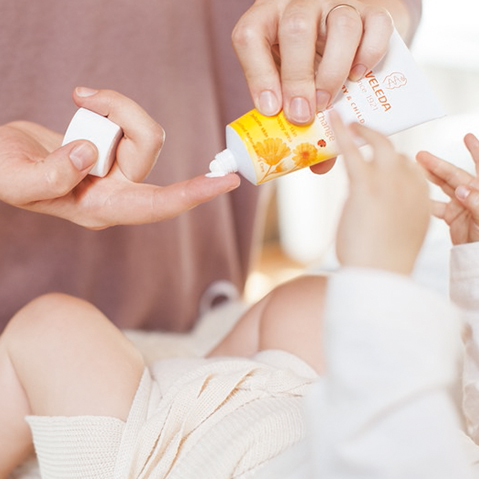
Gentle care for babies’ bottoms
How to gently clean and care for the sensitive nappy area
Interview with Christina Hinderlich
How can I gently clean and care for the sensitive nappy area? And how can I protect my baby from rashes on her bottom? Christina Hinderlich, our midwife, gives tips and information about caring for your baby’s most sensitive area.
What care does the nappy area need?
CH: As the skin in the nappy area comes into repeated contact with urine and faeces, and is warm and damp, it can quickly become irritated or inflamed. I recommend cleaning with warm water and some oil, then carefully drying the skin by patting.
It’s also good to allow the area to come into contact with the air, for example letting the baby wriggle around naked for a while. If the skin becomes red, a special cream should be used. Thanks to its mixture of a soothing calendula extract and zinc oxide, the Calendula Nappy Change Cream is popular in my practice for protecting and strengthening the skin.
How can redness and rashes on the bottom be alleviated?
CH: Throughout the time your baby wears nappies, little spots and pustules, and slight or severe redness can appear on her bottom, and can often cause pain. When this is the case, children often dislike having their nappy changed, but cleaning the area is very important. Using soft cloths, for example cut up muslins, can make the cleaning more comfortable for the baby. In this case, I also recommend cleaning the skin first with lukewarm water then with oil. The oil leaves a soft film on the skin, making the next nappy change a little more comfortable for the baby and caring for the skin.
While the irritation continues, change your baby’s nappy at least every two hours and several times in the night. After cleaning your baby’s bottom, you can also apply a cream with natural oils and zinc oxide once or twice per day. This helps the skin regenerate quickly. Allow the skin to breathe as much as possible. For my children, I cut the nappy area out of some woollen tights for this time, so their tummies and legs stayed warm, but air could reach their bottoms. If the soreness lasts more than two days or you are unsure, ask your midwife or paediatrician for advice. It can be more common in the first weeks and months - but don’t hesitate to ask for advice and help.
All babies give signals that they ‘need to go’. They wriggle, try to make eye contact, become restless or cry.
What nappy is best?
CH: There are many different types of nappy: From the ubiquitous disposable nappy to nappy systems with a fabric lining on the inside and breathable outer material and fabric nappies with a woollen nappy wrap. Each family should find out which version works best for them - in terms of money and time spent. Generally, I recommend breathable versions.
Growing up without nappies?
CH: “Elimination communication” is the term for a method whereby babies are allowed to grow up without nappies. This method was still widespread in Europe until the start of the 20th century. And even today, 75% of all babies around the world don’t wear nappies. “Elimination communication” is not about cleanliness education, but about communication with the baby. Because all babies give signals that they ‘need to go’. They wriggle, try to make eye contact, become restless or cry. If parents respond appropriately, many skin problems in the nappy area can be avoided.

